Links
The AFCoW Links section provides some of the websites that are relevant to AFCoW members. These will include links to researchers, datasets, and analysis about waterbirds in the Asian Flyways. Please feel free to suggest and send useful links to the organizers through the contact page or listserve.
 Birdlife International Asia – The BirdLife Partnership in Asia is active in 16 countries through national grassroots membership NGOs and country programmes (BirdLife in Indochina), and supports project work in countries currently not represented in the BirdLife network. In 2004 the Partnership published a directory documenting 2,293 Important Bird Areas (IBAs) in the 28 countries and territories in the Asia region. Further IBAs have since been identified in a number of national and provincial directories, including the first inventory of sites of conservation importance in mainland China. IBAs are the focus of the BirdLife Asia Partnership’s site, species and habitat conservation work, and their work with local communities. Many Asian countries are experiencing dynamic economic growth, which is putting unprecedented pressure on the continent’s natural environment and biodiversity. Between 2013 and 2020, the BirdLife Asia Partnership aims to save at least 50% of the highly threatened IBAs across Asia from damaging development.
Birdlife International Asia – The BirdLife Partnership in Asia is active in 16 countries through national grassroots membership NGOs and country programmes (BirdLife in Indochina), and supports project work in countries currently not represented in the BirdLife network. In 2004 the Partnership published a directory documenting 2,293 Important Bird Areas (IBAs) in the 28 countries and territories in the Asia region. Further IBAs have since been identified in a number of national and provincial directories, including the first inventory of sites of conservation importance in mainland China. IBAs are the focus of the BirdLife Asia Partnership’s site, species and habitat conservation work, and their work with local communities. Many Asian countries are experiencing dynamic economic growth, which is putting unprecedented pressure on the continent’s natural environment and biodiversity. Between 2013 and 2020, the BirdLife Asia Partnership aims to save at least 50% of the highly threatened IBAs across Asia from damaging development.
LINK: https://www.birdlife.org/asia
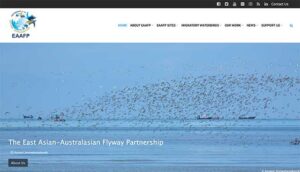 East Asian Australasian Flyway Partnership – The East Asian-Australasian Flyway Partnership (EAAFP) was launched on 6 November 2006. It aims to protect migratory waterbirds, their habitats and the livelihoods of people dependent upon them. There are currently 39 Partners including 18 national governments, 6 intergovernmental agencies, 13 international NGOs, 1 international organisation and 1 international private enterprise. The Partnership provides a flyway wide framework to promote dialogue, cooperation and collaboration between a range of stakeholders to conserve migratory waterbirds and their habitats. Stakeholders include all levels of governments, site managers, technical institutions, UN agencies, development agencies, industrial and private sector, academe, non-government organisations, community groups and local people. EAAFP Partners work together to develop Flyway Site Network to ensure the internationally important wetlands are sustainably managed. It works to enhance research, monitoring, information exchange as well as CEPA (communication, education, participation, awareness) of conservation of migratory waterbirds and their habitats. It enhances capacity building on management and develop flyway-wide conservation approaches.
East Asian Australasian Flyway Partnership – The East Asian-Australasian Flyway Partnership (EAAFP) was launched on 6 November 2006. It aims to protect migratory waterbirds, their habitats and the livelihoods of people dependent upon them. There are currently 39 Partners including 18 national governments, 6 intergovernmental agencies, 13 international NGOs, 1 international organisation and 1 international private enterprise. The Partnership provides a flyway wide framework to promote dialogue, cooperation and collaboration between a range of stakeholders to conserve migratory waterbirds and their habitats. Stakeholders include all levels of governments, site managers, technical institutions, UN agencies, development agencies, industrial and private sector, academe, non-government organisations, community groups and local people. EAAFP Partners work together to develop Flyway Site Network to ensure the internationally important wetlands are sustainably managed. It works to enhance research, monitoring, information exchange as well as CEPA (communication, education, participation, awareness) of conservation of migratory waterbirds and their habitats. It enhances capacity building on management and develop flyway-wide conservation approaches.
LINK: http://Eaaflyway.net
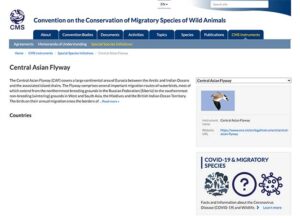 Convention on Conservation of Migratory Species, Central Asian Flyway – The Central Asian Flyway (CAF) covers a large continental area of Eurasia between the Arctic and Indian Oceans and the associated island chains. The Flyway comprises several important migration routes of waterbirds, most of which extend from the northernmost breeding grounds in the Russian Federation (Siberia) to the southernmost non-breeding (wintering) grounds in West and South Asia, the Maldives and the British Indian Ocean Territory. The birds on their annual migration cross the borders of several countries. Geographically the flyway region covers 30 countries of North, Central and South Asia and Trans-Caucasus.
Convention on Conservation of Migratory Species, Central Asian Flyway – The Central Asian Flyway (CAF) covers a large continental area of Eurasia between the Arctic and Indian Oceans and the associated island chains. The Flyway comprises several important migration routes of waterbirds, most of which extend from the northernmost breeding grounds in the Russian Federation (Siberia) to the southernmost non-breeding (wintering) grounds in West and South Asia, the Maldives and the British Indian Ocean Territory. The birds on their annual migration cross the borders of several countries. Geographically the flyway region covers 30 countries of North, Central and South Asia and Trans-Caucasus.
There is an overlap between the CAF and the area of the Agreement on the Conservation of African-Eurasian Migratory Waterbirds (AEWA), which was concluded in 1995, at The Hague, the Netherlands. Sixteen out of the thirty countries encompassed by the CAF are located in the AEWA Agreement Area.
The CAF covers at least 279 populations of 182 migratory waterbird species, including 29 globally threatened and near-threatened species, which breed, migrate and winter within the region. Of those populations, over 50 per cent (145 populations) are covered by AEWA. Many waterbird populations are declining rapidly and the wetlands, grasslands and other habitats upon which they depend are seriously threatened along the CAF due to uncontrolled hunting, habitat degradation, unsustainable water management, and lack of law enforcement and conservation capacity.
LINK: https://www.cms.int/en/legalinstrument/central-asian-flyway
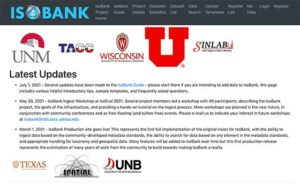 Isobank: IsoBank is a multi-organization effort to build a common repository for stable isotope data. Our goal is to provide a common repository for stable isotope measurement data originating from any context, and to support easy location and access to this data by the research community. The IsoBank repository provides a searchable database of stable isotope measurements based on a rich metadata schema developed through community input from researchers who generate and use stable isotope data.
Isobank: IsoBank is a multi-organization effort to build a common repository for stable isotope data. Our goal is to provide a common repository for stable isotope measurement data originating from any context, and to support easy location and access to this data by the research community. The IsoBank repository provides a searchable database of stable isotope measurements based on a rich metadata schema developed through community input from researchers who generate and use stable isotope data.
LINK: https://isobank.tacc.utexas.edu/
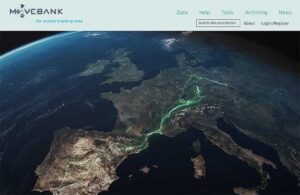 Movebank: Movebank is a free, online database of animal tracking data hosted by the Max Planck Institute of Animal Behavior. We help animal tracking researchers to manage, share, protect, analyze and archive their data.
Movebank: Movebank is a free, online database of animal tracking data hosted by the Max Planck Institute of Animal Behavior. We help animal tracking researchers to manage, share, protect, analyze and archive their data.
LINK: https://movebank.org
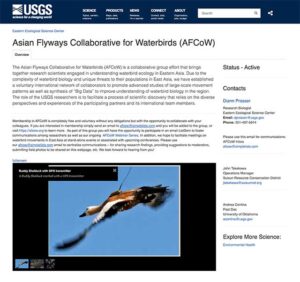 USGS – The U.S. Geological Survey conducts research to improve the scientific understanding of the role wild waterbirds play in the persistence, spread, and amplification of avian influenza viruses around the globe. USGS researchers have a long history of working collaboratively with organizations and individuals in Asian Flyways to foster sustained international collaborations leading to extensive telemetry datasets and publications.
USGS – The U.S. Geological Survey conducts research to improve the scientific understanding of the role wild waterbirds play in the persistence, spread, and amplification of avian influenza viruses around the globe. USGS researchers have a long history of working collaboratively with organizations and individuals in Asian Flyways to foster sustained international collaborations leading to extensive telemetry datasets and publications.
LINK: https://tinyurl.com/2jpm9wzb
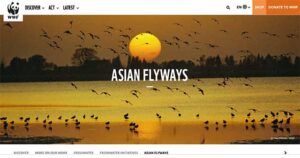 WWF Asian Flyways Initiative: There are several international and national stakeholders and other actors that focus on birds and bird migrations or on water-related issues. But the flyways are about both; the birds require the wetlands as stepping stone corridors and people need the ecosystem services from the wetlands for survival. Linking these two areas of action can provide a stronger argument and tangible indicators of conservation success. This Asian Flyway Initiative is intended to play this role of coordinating among the various organizations and stakeholders to ensure that the avian migratory flyways are conserved as landscapes, with ecologically connected stepping-stone corridors that sustains the long-distance seasonal bird migrations, and the wetlands are managed for nature and people. LINK: https://wwf.panda.org/discover/our_focus/freshwater_practice/freshwater_inititiaves/asian_flyways_initiative/
WWF Asian Flyways Initiative: There are several international and national stakeholders and other actors that focus on birds and bird migrations or on water-related issues. But the flyways are about both; the birds require the wetlands as stepping stone corridors and people need the ecosystem services from the wetlands for survival. Linking these two areas of action can provide a stronger argument and tangible indicators of conservation success. This Asian Flyway Initiative is intended to play this role of coordinating among the various organizations and stakeholders to ensure that the avian migratory flyways are conserved as landscapes, with ecologically connected stepping-stone corridors that sustains the long-distance seasonal bird migrations, and the wetlands are managed for nature and people. LINK: https://wwf.panda.org/discover/our_focus/freshwater_practice/freshwater_inititiaves/asian_flyways_initiative/
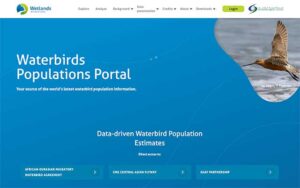 Wetlands International Waterbirds Population Portal: Waterbird Populations Portal (WPP) to catalyse conservation action for waterbirds and their habitats. Globally, there are over 870 waterbird species that serve various important ecosystem services and functions, ranging from the majestic Sarus Crane Grus antigone that stands at over 1.5m tall, making it the tallest flying bird inhabiting wetlands and rice fields in South and South east Asia and Australia, to the diminutive White-winged Flufftail Sarothrura ayresi, restricted to a few areas in wet grasslands in east and southern Africa, both globally threatened species. Conservation of all these species requires easily accessible information on their status and trends to help governments and people take action. The open-access Waterbird Populations Portal (WPP) provides the latest size estimates and trends for over 2,500 populations of 870 waterbird species and presents the latest 1% threshold of each population. The 1% threshold has been used to select 867 Ramsar Sites representing over 35% of total sites listed world wide to date (these represent sites that meet Criterion 6 of the Ramsar Convention on Wetlands).
Wetlands International Waterbirds Population Portal: Waterbird Populations Portal (WPP) to catalyse conservation action for waterbirds and their habitats. Globally, there are over 870 waterbird species that serve various important ecosystem services and functions, ranging from the majestic Sarus Crane Grus antigone that stands at over 1.5m tall, making it the tallest flying bird inhabiting wetlands and rice fields in South and South east Asia and Australia, to the diminutive White-winged Flufftail Sarothrura ayresi, restricted to a few areas in wet grasslands in east and southern Africa, both globally threatened species. Conservation of all these species requires easily accessible information on their status and trends to help governments and people take action. The open-access Waterbird Populations Portal (WPP) provides the latest size estimates and trends for over 2,500 populations of 870 waterbird species and presents the latest 1% threshold of each population. The 1% threshold has been used to select 867 Ramsar Sites representing over 35% of total sites listed world wide to date (these represent sites that meet Criterion 6 of the Ramsar Convention on Wetlands).
The Portal is accessible to national or local authorities for wetland site managers to shortlist relevant populations with their 1% population thresholds, to check against available information and identify potentially internationally or nationally important wetlands. The Portal thus supports governments worldwide to develop and implement management action of wetlands and conserve waterbirds to meet global targets set under the Ramsar Convention on wetlands, related biodiversity-related conventions and flyway agreements and initiatives. Besides formal designations, the Portal offers opportunities to support the identification of Important Bird Areas & Key Biodiversity Areas worldwide. The Portal is widely used by bird and wetland researchers, conservation NGOs, industry and others.
LINK: https://wpp.wetlands.org/
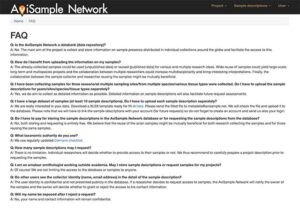 AviSample Network: Ornithologists frequently collect avian tissue samples to study various aspects of birds’ biology and ecology.There are various ways of increasing reproducibility in science – e.g. presence of multiple data repositories collecting raw data. None of these repositories aim to collect or store information on the presence of samples (sample descriptions) that could be used (unpublished samples) or reused (published samples) in different projects, by different researchers or even in different study fields. Moreover, reusing samples from many projects might result in interesting multi-species, long-term or large-scale studies. The collaborations between sample owners and researchers reusing samples from various study fields could significantly increase the research impact or could foster interdisciplinary research with a wide range of applications. Importantly, these collaborations would be mutually beneficial for both researchers providing samples and those reusing them.To facilitate the reuse of avian samples worldwide, we introduce the AviSample Network database with the main aims to collect, store and provide access to avian sample descriptions. We believe that the use of the AviSample Network database will yield a broad range of studies including multi-species and large-scale projects and will help create research networks between ornithologists from across the globe. AviSample Network is currently storing 1670 descriptions of 27,596 avian samples of 407 species. LINK: https://avisample.net/site/faq
AviSample Network: Ornithologists frequently collect avian tissue samples to study various aspects of birds’ biology and ecology.There are various ways of increasing reproducibility in science – e.g. presence of multiple data repositories collecting raw data. None of these repositories aim to collect or store information on the presence of samples (sample descriptions) that could be used (unpublished samples) or reused (published samples) in different projects, by different researchers or even in different study fields. Moreover, reusing samples from many projects might result in interesting multi-species, long-term or large-scale studies. The collaborations between sample owners and researchers reusing samples from various study fields could significantly increase the research impact or could foster interdisciplinary research with a wide range of applications. Importantly, these collaborations would be mutually beneficial for both researchers providing samples and those reusing them.To facilitate the reuse of avian samples worldwide, we introduce the AviSample Network database with the main aims to collect, store and provide access to avian sample descriptions. We believe that the use of the AviSample Network database will yield a broad range of studies including multi-species and large-scale projects and will help create research networks between ornithologists from across the globe. AviSample Network is currently storing 1670 descriptions of 27,596 avian samples of 407 species. LINK: https://avisample.net/site/faq
